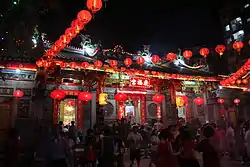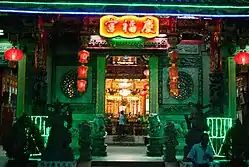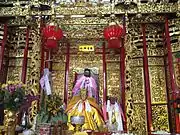Kheng Hock Keong
The Kheng Hock Keong, also known as the Kheng Hock Keong or Qingfu Temple, is the largest and oldest temple to the Chinese sea-goddess Mazu in Yangon, Burma. It is located on the corner of Sintodan Street and Strand Road in Latha Township. Kheng Hock Keong is maintained by a Hokkien Chinese clan association.[1] The temple attracts mostly Hokkien and Hakka worshipers, while the other temple in Latha Township, called the Guanyin Gumiao Temple, attracts Cantonese worshipers.
| Kheng Hock Keong | |
|---|---|
 Kheng Hock Keong in 2013 | |
| Religion | |
| Affiliation | Chinese folk religion, Mazuism |
| Location | |
| Location | 426-432 Strand Road, Yangon |
| Country | Myanmar |
 Shown within Myanmar | |
| Geographic coordinates | 16°46′21.32″N 96°8′55.27″E |
| Architecture | |
| Completed | 1863 |
| Kheng Hock Keong | |||||||||||
|---|---|---|---|---|---|---|---|---|---|---|---|
| Traditional Chinese | 慶福宮 | ||||||||||
| |||||||||||
| Burmese name | |||||||||||
| Burmese | ခိန့်ဟုတ်ဗုဒ္ဓဘာသာဘုရားကျောင်း | ||||||||||
Establishment
It was originally built as a wooden temple in 1861 and completed in 1863, built in the Fujian style, on a tax-exempt plot of land granted by the British authorities.[2][3] The founding Kheng Hock Keong Trust Committee was composed of Rangoon's largest Hokkien clans, representing the Chan-Khoo, Lim, Tan, Yeo, Lee, and Su clans.[3] At the temple's founding, the primary deity was Guanyin. A new brick building was completed in 1903, costing over 153,000 rupees.[2]
Gallery
 Kheng Hock Keong after World War II, in 1945.
Kheng Hock Keong after World War II, in 1945. Kheng Hock Keong at 2013 Chinese New Year
Kheng Hock Keong at 2013 Chinese New Year Kheng Hock Keong at night
Kheng Hock Keong at night Courtyard
Courtyard Entrance
Entrance Main Shrine of Mazu
Main Shrine of Mazu
References
- http://www.chinatownology.com/kheng_hock_keong.html
- Chen, Yi-Sein (1966). "The Chinese in Rangoon during the 18th and 19th Centuries". Essays Offered to G. H. Luce by His Colleagues and Friends in Honour of His Seventy-Fifth Birthday. Volume 1: Papers on Asian History, Religion, Languages, Literature, Music Folklore, and Anthropology. Artibus Asiae Publishers. 23: 107–111. JSTOR 1522640.
- Li, Yi (2017-02-25). Chinese in Colonial Burma: A Migrant Community in A Multiethnic State. Springer. ISBN 9781137519009.